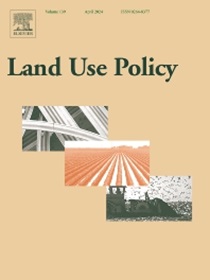受冲突影响地区的森林砍伐:在建设和平期间整合当地观点的定量方法
IF 5.9
1区 社会学
Q1 ENVIRONMENTAL STUDIES
引用次数: 0
摘要
本文探讨了哥伦比亚建设和平背景下与毁林有关的因素。该研究旨在通过将人类感知作为冲突后优先地区毁林的潜在社会经济驱动因素相关因素的代理,了解当地土地利用的变化。从哥伦比亚安蒂奥基亚地区的98组村庄收集了社区对教育、卫生、基础设施和建设和平等社会经济层面的看法。这些信息被分类和加权,以创建三种基于感知的前景:乐观(主要以机会为标志);悲观的(主要以问题为特征);和中性。年毁林率(ADR)数据来自陆地卫星图像,而生物物理和可及性数据来自官方来源。采用广义加性模型评估了森林砍伐与生物物理和社会经济因素之间的关系。研究结果表明,对基础设施和土地适应持乐观态度的人的ADR比持中立态度的人低22.59 %。相反,与悲观前景相比,对住房和卫生主题持乐观态度的ADR高出19.65 %。与此同时,对和解与建设和平主题持悲观态度的人的ADR比持中立态度的人低22.09 %。对于生物物理因素,1.4°C以上的温差和60 ~ 100 mm之间的降水差异与1.8 %或更高的不良反应相关。在可达性方面,距离三级公路越远,ADR越低,从5 公里开始,ADR低于0.6 %。我们将感知与生物物理数据相结合的方法,为在地方层面上与森林砍伐的潜在驱动因素相关的因素提供了新的见解。这为制定保护该区域森林的土地使用政策提供了指导,例如提高对森林价值的认识和促进社区与森林的联系。这种方法可以适用于类似的情况,以提供新的见解,了解人类对社会经济层面的看法与尚未获得数据的大规模森林砍伐之间的关系。本文章由计算机程序翻译,如有差异,请以英文原文为准。
Deforestation in conflict-affected areas: A quantitative approach for integrating local perspectives during peacebuilding
This paper examines deforestation-related factors in Colombia’s peacebuilding context. The study aims to understand local land use change by incorporating human perceptions as proxies for factors associated with underlying socioeconomic drivers of deforestation in post-conflict priority areas. Community perceptions of socioeconomic dimensions such as education, health, infrastructure, and peacebuilding, among others, were gathered from 98 groups of villages in the Antioquia region of Colombia. This information was categorized and weighted to create three perception-based outlooks: Optimistic (primarily marked by opportunities); Pessimistic (primarily marked by problems); and Neutral. Annual deforestation rate (ADR) data was generated from Landsat imagery, while biophysical and accessibility data came from official sources. Generalized additive models were used to assess the relationship between deforestation and biophysical and socioeconomic factors. The findings indicate that Optimistic outlooks on infrastructure and land adaptation were associated with a 22.59 % lower ADR compared to Neutral ones. Conversely, Optimistic outlooks of housing and sanitation topics were associated to a 19.65 % higher ADR compared to Pessimistic outlooks. Meanwhile, Pessimistic outlooks on reconciliation and peacebuilding topics were associated with a 22.09 % lower ADR than the Neutral. For biophysical factors, temperature differences above 1.4 °C and precipitation differences between 60 and 100 mm were associated with ADR of 1.8 % or higher. Regarding accessibility, the greater the distance to tertiary roads, the lower the ADR, which was below 0.6 % from 5 km onwards. Our approach of combining perceptions with biophysical data provides new insights into the factors associated with the underlying drivers of deforestation at a local level. This provides guidance on which to base land-use policies to protect the region's forests, such raising awareness of the value of forests and fostering community links with them. This approach can be adapted to similar contexts to provide new insights on how human perceptions of socioeconomic dimensions relate to deforestation at scales where data is not yet available.
求助全文
通过发布文献求助,成功后即可免费获取论文全文。
去求助
来源期刊

Land Use Policy
ENVIRONMENTAL STUDIES-
CiteScore
13.70
自引率
8.50%
发文量
553
期刊介绍:
Land Use Policy is an international and interdisciplinary journal concerned with the social, economic, political, legal, physical and planning aspects of urban and rural land use.
Land Use Policy examines issues in geography, agriculture, forestry, irrigation, environmental conservation, housing, urban development and transport in both developed and developing countries through major refereed articles and shorter viewpoint pieces.
 求助内容:
求助内容: 应助结果提醒方式:
应助结果提醒方式:


